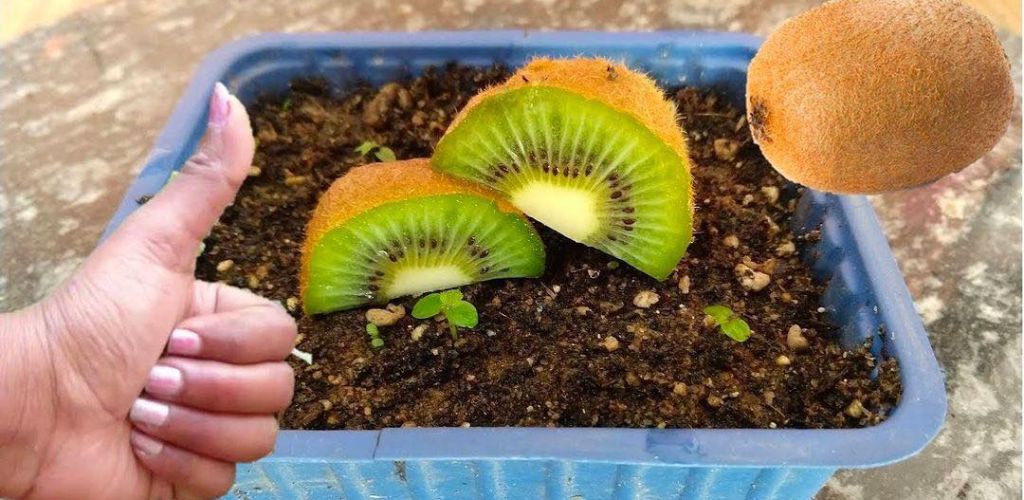Growing a kiwi tree from a kiwi seed can be a fun and rewarding project. However, it is important to note that the kiwifruit sold in stores may not always produce viable seeds, and even if they do, they may not produce the same type of kiwifruit as the mother plant. However, if you have a kiwi with viable seeds, here’s how to grow a young kiwi tree in a pot.
Extract seeds: Cut open a ripe kiwi and hollow out the seeds. Rinse the seeds under cold water and let them dry on a paper towel for a few days.



Films To Make You Question Everything You Know About Cinema

Who Will Take On The Iconic Role Next? Bond Casting Rumors

Germination of the seeds: Kiwi seeds need to be layered (exposed to cold temperatures) in order to germinate. You can stratify the seeds by placing them in a damp paper towel or sphagnum moss and placing them in a plastic bag in the refrigerator for 3-4 weeks. Check the seeds regularly and make sure the paper towel or moss stays moist.
Planting the seeds: Once the seeds are stratified, plant them in a small pot filled with a mixture of potting soil and perlite. Bury the seed about 1/4 inch deep in the soil and water gently. Cover the pot with plastic wrap to create a mini greenhouse and place it in a warm, bright place. Keep the soil moist throughout, but not soaked.
Transplanting the seedlings: After a few weeks, the seedlings should begin to sprout. Once they have several pairs of leaves, they can be transplanted into a larger pot. Use a pot at least 18 to 24 inches in diameter and 24 inches deep filled with a mixture of potting soil, compost, and perlite.
Caring for the kiwi tree: Kiwi trees need plenty of sunlight to grow and bear fruit. Place the pot in a sunny spot or use grow lights if needed. Keep the soil moist throughout, but not soaked. Fertilize the tree with a balanced fertilizer every 4-6 weeks during the growing season.
Provide support: Kiwi trees are vines and need support to grow vertically. Place a trellis or stake in the pot and gently tie the kiwi vine to it as it grows.
Pruning: Prune the kiwi tree in late winter or early spring to remove dead, damaged, or diseased branches. Also, remove any lateral branches growing from the base of the plant.
Harvest: Kiwi trees typically bear fruit in the second or third year of growth. Harvest the fruit when it is fully ripe and slightly soft to the touch.

How do you know kiwis have viable seeds?
There are a few things to look out for when trying to determine if a kiwifruit has viable seeds:
https://googleads.g.doubleclick.net/pagead/ads?client=ca-pub-1155297874051016&output=html&h=280&adk=346536052&adf=4012346790&pi=t.aa~a.1381849204~i.15~rp.4&w=750&fwrn=4&fwrnh=100&lmt=1701704128&num_ads=1&rafmt=1&armr=3&sem=mc&pwprc=5058855833&ad_type=text_image&format=750×280&url=https%3A%2F%2Fwww.rezept-omas.com%2F%3Fp%3D610&ea=0&fwr=0&pra=3&rh=188&rw=749&rpe=1&resp_fmts=3&wgl=1&fa=27&uach=WyJXaW5kb3dzIiwiOC4wLjAiLCJ4ODYiLCIiLCIxMTguMC4yMDg4LjQ2IixudWxsLDAsbnVsbCwiMzIiLFtbIkNocm9taXVtIiwiMTE4LjAuNTk5My43MSJdLFsiTWljcm9zb2Z0IEVkZ2UiLCIxMTguMC4yMDg4LjQ2Il0sWyJOb3Q9QT9CcmFuZCIsIjk5LjAuMC4wIl1dLDBd&dt=1701704128239&bpp=9&bdt=5305&idt=12&shv=r20231129&mjsv=m202311280101&ptt=9&saldr=aa&abxe=1&cookie=ID%3D6ffbac4f8fdb1a28%3AT%3D1699259687%3ART%3D1701702187%3AS%3DALNI_MaZ7xRj2vDxQTyQV9gltIKMm39ynA&gpic=UID%3D00000cc986c570a5%3AT%3D1699259687%3ART%3D1701702187%3AS%3DALNI_MatRVmpKnoGSzs5fQSVGZP8PBZJbQ&prev_fmts=0x0%2C1200x280&nras=3&correlator=4418034325989&frm=20&pv=1&ga_vid=401349391.1699259645&ga_sid=1701704125&ga_hid=1649033715&ga_fc=1&ga_cid=1089828007.1701428242&u_tz=60&u_his=10&u_h=720&u_w=1280&u_ah=680&u_aw=1280&u_cd=24&u_sd=1.5&dmc=2&adx=253&ady=3551&biw=1257&bih=606&scr_x=0&scr_y=1268&eid=44759876%2C44759927%2C44759837%2C42532601%2C31078301%2C44807764%2C44808148%2C44808285%2C44809072&oid=2&pvsid=4495513710758889&tmod=1253646243&wsm=1&uas=0&nvt=3&ref=https%3A%2F%2Fwww.rezept-omas.com%2F%3Fpaged%3D85&fc=1408&brdim=0%2C0%2C0%2C0%2C1280%2C0%2C1280%2C680%2C1272%2C606&vis=1&rsz=%7C%7Cs%7C&abl=NS&fu=128&bc=31&psd=W251bGwsbnVsbCxudWxsLDNd&ifi=3&uci=a!3&btvi=1&fsb=1&dtd=57



Who Will Be the Next James Bond? Here’s What We Know So Far

From Albinos To Polygamists: The World’s Most Unique Families

Gina Carano Finally Admits What Some Suspected All Along
Choose a ripe kiwi: Kiwis with viable seeds are usually fully ripe and have a slightly soft texture when gently pressed.
Check the seeds: Cut open the kiwis and carefully remove the seeds. Look for seeds that are plump and full, rather than shrunken or underdeveloped.
Test germination: To determine if the seeds are capable of germination, you can perform a germination test. Simply moisten a paper towel or piece of peat moss, place the seeds on top and wrap them in plastic wrap or place them in a plastic bag. Store the seeds in a warm, bright place and check regularly for signs of germination. If the seeds sprout within a few weeks, they are likely viable and ready to be planted.
It is important to note that even if a kiwifruit has viable seeds, the resulting plant may not produce the same type of kiwifruit as the mother plant. Kiwi trees are typically propagated by grafting, which ensures that the resulting tree produces the same type of fruit as the mother plant. Nonetheless, growing a kiwi tree from seed can still be a fun and rewarding project.

